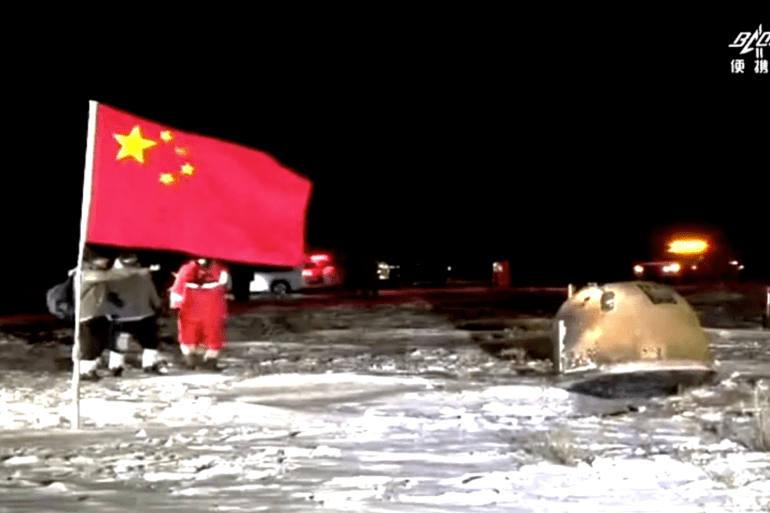China’s lunar mission Chang’e returns to Earth with Moon rocks
China becomes only the third country to have retrieved samples from the Moon following the US and the Soviet Union in the 1960s and 70s.

A Chinese spacecraft carrying rocks and soil from the Moon returned safely to Earth early on Thursday in the first mission in four decades to collect lunar samples, the Xinhua news agency said.
The capsule carrying the samples collected by the Chang’e-5 space probe landed in northern China’s Inner Mongolia region, Xinhua said, quoting the China National Space Administration (CNSA).
Keep reading
list of 3 itemsChinese capsule with 2kg of moon rocks begins journey to Earth
Chinese spacecraft first to land on ‘dark side’ of moon
The agency’s director, Zhang Kejian, declared the mission a success, Xinhua said.
Al Jazeera’s Katrina Yu, reporting from Beijing, said that President Xi Jinping congratulated the team involved in the probe shortly after the mission was completed.
“For China, this is really significant. They really want this to be source of national pride, and a source of triumph.”
With this mission, China became only the third country to have retrieved samples from the Moon, following the United States and the Soviet Union in the 1960s and 1970s.
Beijing is looking to catch up with Washington and Moscow after taking decades to match its rivals’ achievements and has poured billions into its military-run space programme.
Chang’e-5, named after a mythical Chinese Moon goddess, landed on the Moon on December 1. While there, it raised the Chinese flag, the country’s space agency said.
‘Ocean of Storms’
When the probe left the Moon two days later, that marked the first time that China had achieved takeoff from an extraterrestrial body, it said.
The module then went through the delicate operation of linking up in lunar orbit with the part of the spacecraft that brought the samples back to Earth.
Scientists hope the samples will help them learn about the Moon’s origins, formation and volcanic activity on its surface.
The Chang’e-5 mission was to collect two kilograms (4.5 pounds) of material in an area known as Oceanus Procellarum – or “Ocean of Storms” – a vast, previously unexplored lava plain, according to the science journal Nature.
The capsule will be airlifted to Beijing for opening, and the Moon samples will be delivered to a research team for analysis and study, the space agency said.
Space dream
China will make some of the samples available to scientists in other countries, Pei Zhaoyu, deputy director of the Lunar Exploration and Space Program Center of CNSA, has said.
Xinhua described the mission as one of the most challenging and complicated in China’s aerospace history.
The probe comprised separate craft to get to the Moon, land on it and collect the samples, get back up and then return the rocks and soil to Earth, Xinhua said.
The return capsule entered the Earth’s atmosphere at an altitude of about 120km (75 miles). When it was about 10km above land, a parachute opened and it landed smoothly, after which a search team recovered it, the agency said.
This was the first such attempt to collect such samples since the Soviet Union’s Luna 24 mission in 1976.

Under President Xi, plans for China’s “space dream”, as he calls it, have been put into overdrive.
China hopes to have a crewed space station by 2022 and eventually send humans to the Moon by the 2030s, Al Jazeera’s Yu said.
“What China really wants to do going forward is eventually become a major power when it comes to space exploration.”
She noted that China was very careful in managing the launch and the landing, avoiding a live broadcast of the event “to avoid any embarrassment should anything go wrong.”
“The Chinese government is trying to manage this narrative very carefully, because they see this as an important for the international image of China.”
China launched its first satellite in 1970, while human spaceflight took decades longer – with Yang Liwei becoming the country’s first “taikonaut” in 2003.
A Chinese lunar rover landed on the far side of the Moon in January 2019 in a global first that boosted Beijing’s aspirations to become a space superpower.
The latest probe is among a slew of ambitious targets, which include creating a powerful rocket capable of delivering payloads heavier than those NASA and private rocket firm SpaceX can handle, a lunar base, a permanently crewed space station, and a Mars rover.